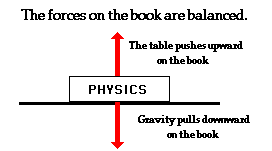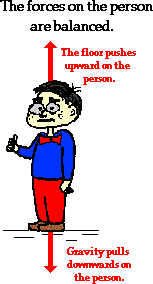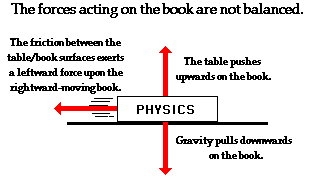An object at rest stays at rest and an object in motion stays in motion with the same speed and in the same direction unless acted upon by an unbalanced force.
But what exactly is meant by the phrase unbalanced force? What is an unbalanced force? In pursuit of an answer, we will first consider a physics book at rest on a tabletop. There are two forces acting upon the book. One force - the Earth's gravitational pull - exerts a downward force. The other force - the push of the table on the book (sometimes referred to as a normal force) - pushes upward on the book.

Consider another example involving balanced forces - a person standing upon the ground. There are two forces acting upon the person. The force of gravity exerts a downward force. The floor of the floor exerts an upward force.

Now consider a book sliding from left to right across a tabletop. Sometime in the prior history of the book, it may have been given a shove and set in motion from a rest position. Or perhaps it acquired its motion by sliding down an incline from an elevated position. Whatever the case, our focus is not upon the history of the book but rather upon the current situation of a book sliding to the right across a tabletop. The book is in motion and at the moment there is no one pushing it to the right. (Remember: a force is not needed to keep a moving object moving to the right.) The forces acting upon the book are shown below.

To determine if the forces acting upon an object are balanced or unbalanced, an analysis must first be conducted to determine what forces are acting upon the object and in what direction. If two individual forces are of equal magnitude and opposite direction, then the forces are said to be balanced. An object is said to be acted upon by an unbalanced force only when there is an individual force that is not being balanced by a force of equal magnitude and in the opposite direction. Such analyses are discussed in Lesson 2 of this unit and applied in Lesson 3.
No comments:
Post a Comment